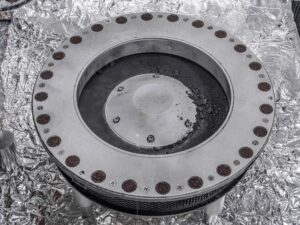
Language is messy, and changing definitions of how words are used can sometimes make science messy, too.
Late one night last week, I was binge-scrolling science on social media when I stumbled across reports that initial analysis of Bennu samples indicated that it was made of debris from an ocean world.
As a child of the 80s, I think of Earth as a water world – a pale blue dot covered in oceans and home to whales that one day Mr. Spock will bond with and transport to the future… or something like that.
And I wasn’t the only one thinking like that – another human, whose name is withheld to protect their identity, posted about how wild it would be if OSIRIS-REx had flown all that way only to discover a bit of Earth that got splashed into space with some dinosaurs.
And I went to sleep hoping that would be exactly what happened.
This is how I learned that today, “ocean world” refers to small moons and objects like Pluto that have ice shells over liquid oceans that are kept warm by very violent physics. Earth is a terrestrial world, and compared to tiny moons like Enceladus, we just don’t have all that much water as a function of volume.

In a citation that brings me joy, the Guinness World Records notes, “Models based on the gravitational field of the moon suggest that Enceladus’ ocean may have a volume of roughly 15,000,000 km³.” With a 500-km diameter, this makes it 23% ocean by volume. Newly acknowledged ocean world Ganymede is 46% water! They still aren’t mostly water, but they have got water.
Meanwhile, Earth, the Guinness record holder for total water, has 1,361,620,510 km³ of water, which is just 0.125% of our world. We are – by volume – not a water world. We are just a rock covered in water.
Back to Bennu. Bennu, much to my sadness, is not a pile of rubble that resulted from something bad happening to Earth or an Earth-like world.
Instead, Bennu is a rubble pile made from the destruction of a world like Europa, Enceladus, or maybe even giant Ganymede. At some point in our solar system’s past, one of these ocean-filled worlds got the structure knocked out of it, and the remaining gravel pile became part of what is now Bennu.
And while this story is less human-centric than if that had been a gravel pile of Earth out there, it is actually scientifically super important. We can dig around on our world and the Moon and study our origins pretty well. We can’t – at least with our current technology and science funding – go out and dig around on any of these ocean worlds. Bennu is thus giving us a chance to study the stuff of planets we won’t be able to visit for a decade, and even then, won’t be able to dig chunks out of. This is new. This is exciting.
I still wish it was a piece of Earth that was ejected in the demise of the dinos, but I just like dinosaurs.
